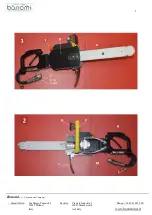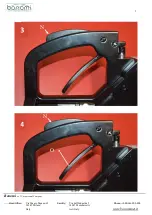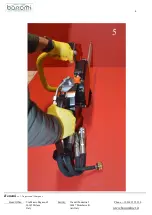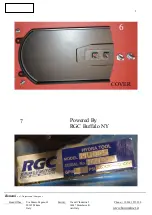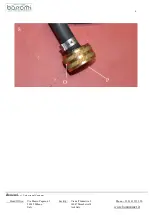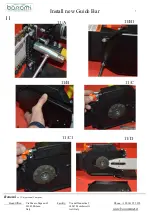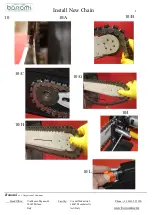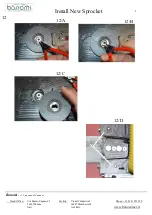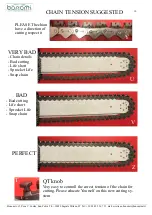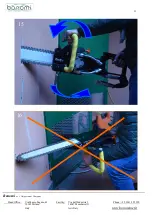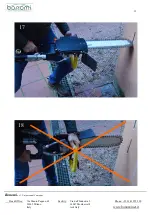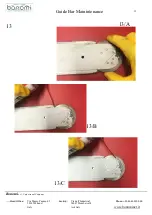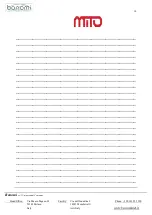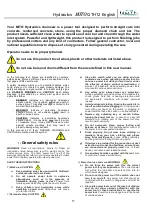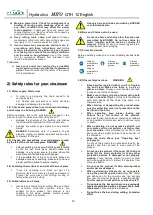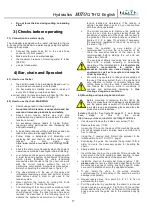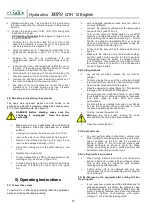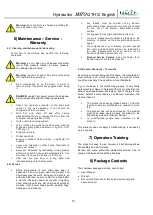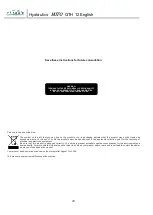
Hydraulics
Mito
QTH 12 English
16
d) Maintain power tools. Check for misalignment or
binding of moving parts, breakage of parts and
any other condition that may affect the power
tools operation.
lf damaged, have the power tool
repaired before use. Many accidents are caused by
poorly maintained power tools.
e) Keep cutting tools sharp and clean.
Properly
maintained cutting tools with sharp cutting edges are
less likely to >>>> and are easier to control.
f) Use the power tool, accessories and tools etc., in
accordance with these instructions and in the
manner intended for the particular type of power
tool, taking into account the working conditions
and the work to be performed.
Use of the power
tool for operations different from intended could
result in a hazardous situation.
5)
Service
e)
Have your power tool serviced by a qualified
repair person using only identical replacement
parts.
This will ensure that the safety of the power
tool is maintained.
2
2
)
)
S
S
a
a
f
f
e
e
t
t
y
y
r
r
u
u
l
l
e
e
s
s
f
f
o
o
r
r
y
y
o
o
u
u
r
r
c
c
h
h
a
a
i
i
n
n
s
s
a
a
w
w
2.1) Water supply: Safety rules
In order to run properly, the chain needs to be
cooled by water.
2.4) Checks and precautions to avoid structural
damage and damage to a building
2.2) Checks and precautions to avoid structural damage
and damage to a building. DANGER
Before operating, talk to the construction manager or the
planner in order to make sure that cutting doesn’t:
damage the structure of the building and change
the structural characteristics of the construction;
damage any water or gas pipeline or any electric
mains.
DANGER
Particularly care if presence of gas
pipeline, cutting iron sparks is present and can be a
comburent for the gas
2.3) Checks and precautions to avoid damage caused
by the fall of the cut out work piece. DANGER
before operating, make sure that the possible falling
of the cut out work piece doesn't make any
damage. In any case, secure the area where the
work piece can fall and signal the danger;
if the possible fall of the cut out work piece can
damage anybody or anything, make sure to have a
proper system in place to secure it safely.
2.4) Fastening the work piece and size of the work piece
if you are operating on a block not part of a
structure, fasten it in order to prevent its movement.
Prevent the work piece from shifting, moving or
falling when you are cutting.
2.5) Suitable Bars and Chians
Use bars and chains for wet cutting. Bars and chain
for concrete, reinforced concrete, stone, are
suitable for your product. Your product is not
suitable to cut wood, plastics, metals (except
reinforcing bars in concrete).
Use only bars and chains provided by BONOMI
or authorized dealer.
2.6) Bars and Chains not to be used
Do not use bars and chains other than the ones
prescribed by BONOMI. Do not use chains for
wood, tungsten carbide chains or chains for
masonry.
Chains for wood or masonry generate a
kickback effect when plunging.
2.7) Protective devices
Before operating make sure to wear all safety devices listed
below:
Always
wear safety
goggles
Always
wear safety
gloves
Always
wear ear
protection
Always
wear safety
shoes
2.8) Other safety directions. WARNING
Keep handles (pointed with H and F in figures)
dry and clean. Make sure there is no oil or
grease on them.
Greasy or wet handles can lead
to lose control of the chainsaw.
Make sure to firmly grip the product using both
hands on handles (fig. 5).
F
irmly hold the product
with both hands till the chain has come to a
complete stop.
When storing or transporting the product make
sure the protecting cover (not present) is on the
bar (B) and chain (A)
.
When operating, keep proper footing and
balance for a full control of the product.
Improper footing and balance, operating on ladders
or on unstable structure can lead to serious injury
or death.
When operating do not excessive stretch out
your arms and do not perform cut higher than
your shoulders.
Arms stretched too far out or cuts
above shoulder height can lead to loss of control of
the chainsaw.
Keep the chain sharp (see “Operating tips”
paragraph).
A not dull chain leads to an excessive feed by the
operator and this can lead to lose control of the
product.
Do not use the product if the cover (D), the front
panel (G), the slurry protector (I) or any other
protection devices is damaged or not properly
working.
Those devices prevent to get in contact
with moving parts and to protect the operator from
slurry and debris.
Do not use the product if chain, main sprocket
and/or bar are damaged.
When performing vertical cuts, do not operate
using the product upside down (fig. 18).
Water
and debris can hit the operator and can wrongly
flow over the product leading to a possible danger.
For this reason do not perform overhead cuts!!!
Do not place the bar and chain in a previously
made cut performed with a narrower chain (less
than 6 mm).
This can lead to a kickback.
Do not force the bar, during cutting, to torsion
effort

